Proposing a Wetland-Based Economic Approach for Wastewater Treatment in Arid Regions as an Alternative Irrigation Water Source
Abstract
1. Introduction
2. Materials and Methods
2.1. The Study Area
2.2. Water Quality Data
2.3. HSSF- and VF-CW’s Model Descrpition
2.4. Proposed HSSF and VF-CWs Construction Details
2.5. Modeling HSSF-CW and VF-CW Efficiencies Using the P-K-C*
- Use the input model data summarized in Table 2 and obtain the HSSF and VF-CWs areas for the BOD, TP, and FC by utilizing Equation (1).
- Obtain the hydraulic residence time (RT) from Equation (3).
- The design area is the area corresponding to the maximum RT in days.
- Determine the surface loading rate (q) from Equation (3).
- Obtain the length and width in (m) for the HSSF and VF-CWs based on an aspect length-to-width ratio of 1:1
- Divide the CW width into n cells based on a cell width of 8.0 m, and by doing so, the number of cells (n) = width/8.0.
2.6. The Cost Function for Treating Wastewater
3. Results
3.1. HSSF and VF-CWs Removal Efficiencies
3.2. HSSF and VF-CWs Sizing Design Curves
3.3. HSSF and VF-CWs Water Balance
4. Discussion
4.1. HSSF and VF-CWs Efficiencies
4.2. Cost Estimation Analysis
5. Conclusions
Author Contributions
Funding
Informed Consent Statement
Data Availability Statement
Acknowledgments
Conflicts of Interest
References
- Holding Company for Water and Wastewater (HCWW). Governorates datasheets. In 2030 Strategic Vision for Treated Wastewater Reuse in Egypt. Water Resources Management Program—CEDARE; AbuZeid M.K., CEDARE, Eds.; 2014. Nile Corniche, As Sahel, Rod El Farag, Cairo Governorate, Egypt. Available online: https://www.hcww.com.eg/ (accessed on 14 July 2022).
- Holding Company for Water and Wastewater (HCWW). Data and Statistics 2019. Available online: https://www. (accessed on 30 June 2022).
- MWRI, Ministry of Water and Irrigation. The National Water Resources Plan, 2037, Egypt. 2017. Available online: https://www.mwri.gov.eg/nwrpeg/index.php?option=com_content&view=category&layout=blog&id=34&Itemid=55 (accessed on 15 June 2022).
- Abdelazim, M.N. Unconventional water resources and agriculture in Egypt. In The Handbook of Environmental Chemistry; Springer: Cham, Switzerland, 2019. [Google Scholar] [CrossRef]
- Gabr, M.; Elzahar, M. Study of the quality of irrigation water in South-East El-Kantara Canal, North Sinai, Egypt. IJESD 2018, 9, 142–146. [Google Scholar] [CrossRef]
- Gabr, M. Evaluation of irrigation water, drainage water, soil salinity, and groundwater for sustainable cultivation. Irrig. Drain. Sys Eng. 2018, 7, 224. [Google Scholar]
- Mohamed, H.T.; Jaime, H.; Amgad, E.; Petra, H. Unpacking wastewater reuse arrangements through a new framework: Insights from the analysis of Egypt. Water Int. 2021, 46, 605–625. [Google Scholar] [CrossRef]
- Gabr, M.E. Study of reclaimed water reuse standards and prospects in irrigation in Egypt. Port-Said Eng. Res. J. 2020, 24, 65–75. [Google Scholar] [CrossRef]
- El-Hawary, A.; Shaban, M. Improving drainage water quality: Constructed wetlands-efficiency assessment using multivariate and cost analysis. Water Sci. 2018, 32, 301–317. [Google Scholar] [CrossRef]
- Gabr, M.E. Proposing a constructed wetland within the branch drains network to treat degraded drainage water in Tina Plain, North Sinai, Egypt. Arch Agron. Soil Sci. 2021, 67, 1479–1494. [Google Scholar] [CrossRef]
- Gabr, M.E. Design methodology for sewage water treatment system comprised of Imhoff’s tank and a subsurface horizontal flow constructed wetland: A case study Dakhla Oasis, Egypt. J. Environ. Sci. Health Part A 2022, 57, 52–64. [Google Scholar] [CrossRef]
- Sami, U.B.; Umara, Q. Implications of Sewage Discharge on Freshwater Ecosystems; IntechOpen: Rijeka, Croatia, 2021. [Google Scholar] [CrossRef]
- Tao, Z. Sewage—Recent Advances, New Perspectives and Applications; IntechOpen: Rijeka, Croatia, 2022. [Google Scholar] [CrossRef]
- Roberto, A.; Onintze, P.; Leire, G.; Mikel, M.; Leire, U.; Federico, M. Modelling and simulation of subsurface horizontal flow constructed wetlands. J. Water Proc. Eng. 2022, 47, 102676. [Google Scholar]
- Thalla, A.K.; Devatha, C.P.; Anagh, K.E. Sony, Performance evaluation of horizontal and vertical flow constructed wetlands as tertiary treatment option for secondary effluents. Appl. Water Sci. 2019, 9, 147. [Google Scholar] [CrossRef]
- Merriman, L.S.; Hathaway, J.M.; Burchell, M.R.; Hunt, W.F. Adapting the relaxed tanks-in-series model for stormwater wetland water quality performance. Water 2017, 9, 691. [Google Scholar] [CrossRef]
- Wojciech, D.; Beata, K.; Paweł, M.; Dariusz, B. Modeling of pollutants removal in subsurface vertical flow and horizontal flow constructed wetlands. Water 2019, 11, 180. [Google Scholar] [CrossRef]
- Hassan, I.; Chowdhury, S.R.; Prihartato, P.K.; Razzak, S.A. Wastewater treatment using constructed wetland: Current trends and future potential. Processes 2021, 9, 1917. [Google Scholar] [CrossRef]
- Gabr, M.E. Design methodology of a new surface flow constructed wetland system, case study: East South EL-Kantara Region North Sinai, Egypt. Port-Said Eng. Res. J. (PEERJ) 2020, 24, 23–34. [Google Scholar] [CrossRef]
- Kadlec, R.H.; Wallace, S. Treatment Wetlands, 2nd ed.; CRC Press: Boca Raton, FL, USA, 2009; Available online: https://www.routledge.com/Treatment-Wetlands/KadlecWallace/p/book/9781566705264 (accessed on 15 July 2022).
- Kadlec, R.H. The inadequacy of first-order treatment wetland models. Ecol. Eng. 2000, 15, 105–119. Available online: https://www.sciencedirect.com/science/article/pii/S0925857499000397 (accessed on 10 July 2022). [CrossRef]
- Laaffat, J.; Ouazzani, N.; Mandi, L. The evaluation of potential purification of a horizontal subsurface flow constructed wetland treating greywater in semi-arid environment. Proc. Saf. Environ. Prot. 2015, 95, 86–92. Available online: https://www.sciencedirect.com/science/article/pii/S0957582015000397 (accessed on 10 July 2022). [CrossRef]
- Mohammed, N.A.; Ismail, Z.Z. Prediction of pollutants removal from cheese industry wastewater in constructed wetland by artificial neural network. Int. J. Environ. Sci. Technol. 2021, 19, 9775–9790. [Google Scholar] [CrossRef]
- Samso, R.; García, J.; Molle, P.; Forquet, N. Modelling bio-clogging in variably saturated porous media and the interactions between surface/subsurface flows: Application to constructed wetlands. J. Environ. Manag. 2016, 165, 271–279. [Google Scholar] [CrossRef]
- Dittrich, E.; Klincsik, M.; Somfai, D.; Dolgos-Kov, A.; Kiss, T.; Szekeres, A. Application of divided convective-dispersive transport model to simulate variability of conservative transport processes inside a planted horizontal subsurface flow constructed wetland. Environ. Sci. Pollut. Res. 2021, 28, 15966–15994. [Google Scholar] [CrossRef]
- Austin, D.; Vazquez-Burney, R.; Dyke, G.; King, T. Nitrification and total nitrogen removal in a super-oxygenated wetland. Sci. Total Environ. 2019, 652, 307–313. [Google Scholar] [CrossRef]
- Vymazal, J. The historical development of constructed wetlands for wastewater treatment. Land 2022, 11, 174. [Google Scholar] [CrossRef]
- George, P.; Ioanna, Z.; Helen, K.; Anna, M.; Georgios, B.; Vassilios, A.T.; Ioannis, N. Efficiency of pilot-scale constructed floating wetlands in the removal of nutrients and pesticides. Water Resour. Manag. 2022, 36, 399–416. [Google Scholar]
- Al-Gheethi, A.A.; Norli, I.; Efaq, A.; Bala, J.; Alamery, R. Solar disinfection and lime treatment processes for reduction of pathogenic bacteria in sewage treated effluents and biosolids before reuse for agriculture in Yemen. JWRD 2015, 5, 419–429. [Google Scholar]
- Madleen, S.; Gabr, M.E.; Mohamed, M.; Hani, M. Random Forest modelling and evaluation of the efficiency of a full-scale subsurface constructed wetland plant in Egypt. Ain Shams Eng. J. 2022, 13, 101778. [Google Scholar]
- Mustafa, H.M.; Hayder, G. Recent studies on applications of aquatic weed plants in phytoremediation of wastewater: A review article. Ain Shams Eng. J. 2021, 12, 355–365. [Google Scholar] [CrossRef]
- Rashed, A. Treatment of municipal pollution through re-engineered drains: A case study, Edfina Drain, West Nile Delta. In Proceedings of the 11th International Commission on Irrigation and Drainage (ICID), International Drainage Workshop (IDW), Cairo, Egypt, 22–24 September 2012. [Google Scholar]
- Alexandros, I.S. The role of constructed wetlands as green infrastructure for sustainable urban water management. Sustainability. 2019, 11, 6981. [Google Scholar]
- Reetika, S.; Gupta, D.; Gurudatta, S.; Virendra, K.M. Efficiency of horizontal flow constructed wetland for secondary treatment domestic wastewater in a Remote Tribalarea of Central India. Sustain. Environ. Res. 2021, 31, 13. [Google Scholar]
- Chen, J.; Ying, G.G.; Liu, Y.S.; Wei, X.D.; Liu, S.S.; He, L.Y.; Yang, Y.Q.; Chen, F.R.; Fan-Rong, C. Nitrogen removal and its relationship with the nitrogen-cycle genes and microorganisms in the horizontal subsurface flow constructed wetlands with different design parameters. J. Environ. Sci. Health A Tox. Hazard Subst. Environ. Eng. 2017, 52, 804–818. [Google Scholar] [CrossRef]
- Molinos-Senante, M.; Hernández-Sancho, F.; Sala-Garrido, R. Economic feasibility study for wastewater treatment: A cost–benefit analysis. Sci. Total Environ. 2010, 408, 4396–4402. [Google Scholar] [CrossRef]
- MWRI. Reference Conditions for the Project of 1.5 Million Acres in Egypt; Ministry of Water Resources and Irrigation: Giza, Egypt, 2015. [Google Scholar]
- FAO. CROPWAT 8 Software by Land and Water Division. 2022. Available online: http://www.fao.org/land-water/databases-and-software/cropwat/en/ (accessed on 10 July 2022).
- Egypt Decree No. 208/2018. For the Protection of the Nile River and Its Waterways from Pollution, Decree of the Minister of Water Resources and Irrigation for the Executive Regulation of Law 48/1982. 2018. Available online: https://www.mwri.gov.eg/index.php/ministry/ministry-17/12-1984 (accessed on 2 July 2022). (In Arabic)
- Trang, N.T.D.; Konnerup, D.; Schierup, H.; Chiem, N.H.; Tuan, L.A.; Brix, H. Kinetics of pollutant removal from domestic wastewater in a tropical horizontal subsurface flow constructed wetland system: Effects of hydraulic loading rate. Ecol. Eng. 2010, 36, 527–535. [Google Scholar] [CrossRef]
- Gajewska, M.; Skrzypiec, K. Kinetics of nitrogen removal processes in constructed wetlands. In Proceedings of the E3S web conference 26 00001, Gdansk, Poland, 22–25 June 2018. [Google Scholar]
- Reed, S.C.; Crites, R.W.; Middlebrooks, E.J. Natural Systems for Waste Management and Treatment, 2nd ed.; McGraw-Hill, Inc.: New York, NY, USA, 1995. [Google Scholar]
- Rashed, A. Reciprocating subsurface wetlands for drainage water treatment a case study in Egypt. MEJ. 2007, 32, 3. [Google Scholar] [CrossRef]
- Andreia, S.G.; Flavio, T.; de José Donizetti, L.; Mauro, L.; Shirley, S.T. Economic feasibility for selecting wastewater treatment systems. Water Sci. Technol. 2018, 78, 2518–2531. [Google Scholar]
- Molinos-Senante, M.; Garrido-Baserba, M.; Reif, R.; Hernández-Sancho, F.; Poch, M. Assessment of wastewater treatment plant design for small communities: Environmental and economic aspects. Sci. Total Environ. 2012, 427, 11–18. [Google Scholar] [CrossRef] [PubMed]
- Bellver-Domingo, A.; Fuentes, R.; Hernández-Sancho, F.; Carmona, E.; Picó, Y.; Hernández-Chover, V. Monetary valuation of salicylic acid, methylparaben and THCOOH in a Mediterranean coastal wetland through the shadow prices methodology. Sci. Total Environ. 2018, 627, 869–879. [Google Scholar] [CrossRef]
- Gkika, D.; Georgios, D.G.; Vassilios, A.T. Construction and Operation Costs of Constructed Wetlands Treating Wastewater. Water Sci. Technol. 2014, 70, 803–810. [Google Scholar] [CrossRef] [PubMed]
- Virendra, K.M.; Philipp, O.; Reetika, S.; Alexander, G.; Alvarez, J.A.; Nadeem, K.; Cristina, A.; Carlos, A.; Iztok, A. Application of horizontal flow constructed wetland and solar driven disinfection technologies for wastewater treatment in India. Water Pract. Technol. 2018, 13, 469–480. [Google Scholar] [CrossRef]
- Mustafa, A. Constructed wetland for wastewater treatment and reuse: A case study of developing country. Int. J. Environ. Sci. Dev. 2013, 4, 20–24. [Google Scholar] [CrossRef]
- Abdel Razik, A.Z.; Mahmoud, M.E.; Ahmed, A.R.; Mohamed, A.E. Wastewater treatment in horizontal subsurface flow constructed wetlands using different media (Setup Stage). Water Sci. 2015, 29, 26–35. [Google Scholar]
- Diana, I.H.; Sulistyoweni, W.; Setyo, S.M.; Robertus, W.T. The performance of subsurface constructed wetland for domestic wastewater treatment. IJERT 2013, 2, 3374–3382. [Google Scholar]
- Six, J.; Feller, C.; Denef, K.; Ogle, S.M. Soil organic matter, biota and aggregation in temperate and tropical soils–Effects of no-tillage. Agronomie 2002, 22, 755–775. [Google Scholar] [CrossRef]
- Herrera-Cárdenas, J.; Navarro, A.E.; Torres, E. Effects of porous media, macrophyte type and hydraulic retention time on the removal of organic load and micropollutants in con-structed wetlands. J. Environ. Sci. Health Part A 2016, 51, 380–388. [Google Scholar] [CrossRef]
- Shahid, M.J.; AL-surhanee, A.A.; Kouadri, F.; Ali, S.; Nawaz, N.; Afzal, M.; Rizwan, M.; Ali, B.; Soliman, M.H. Role of Microorganisms in the Remediation of Wastewater in Floating Treatment Wetlands: A Review. Sustainability 2020, 12, 5559. [Google Scholar] [CrossRef]
- Ghezali, K.; Bentahar, N.; Barsan, N.; Nedeff, V.; Mos, N.E. Potential of Canna indica in Vertical Flow Constructed Wetlands for Heavy Metals and Nitrogen Removal from Algiers Refinery Wastewater. Sustainability 2022, 14, 4394. [Google Scholar] [CrossRef]
- Ioannidou, V.; Stefanakis, A.I. The use of constructed wetlands to mitigate pollution from agricultural runoff. In Contaminants in Agriculture; Naeem, M., Ansari, A., Gill, S., Eds.; Springer: Cham, Switzerland, 2020. [Google Scholar] [CrossRef]
- Stefanakis, A.I.; Akratos, C.S.; Tsihrintzis, V.A. Vertical Flow Constructed Wetlands: Eco-Engineering Systems for Wastewater and Sludge Treatment, 1st ed.; Elsevier: Amsterdam, The Netherlands, 2014. [Google Scholar]
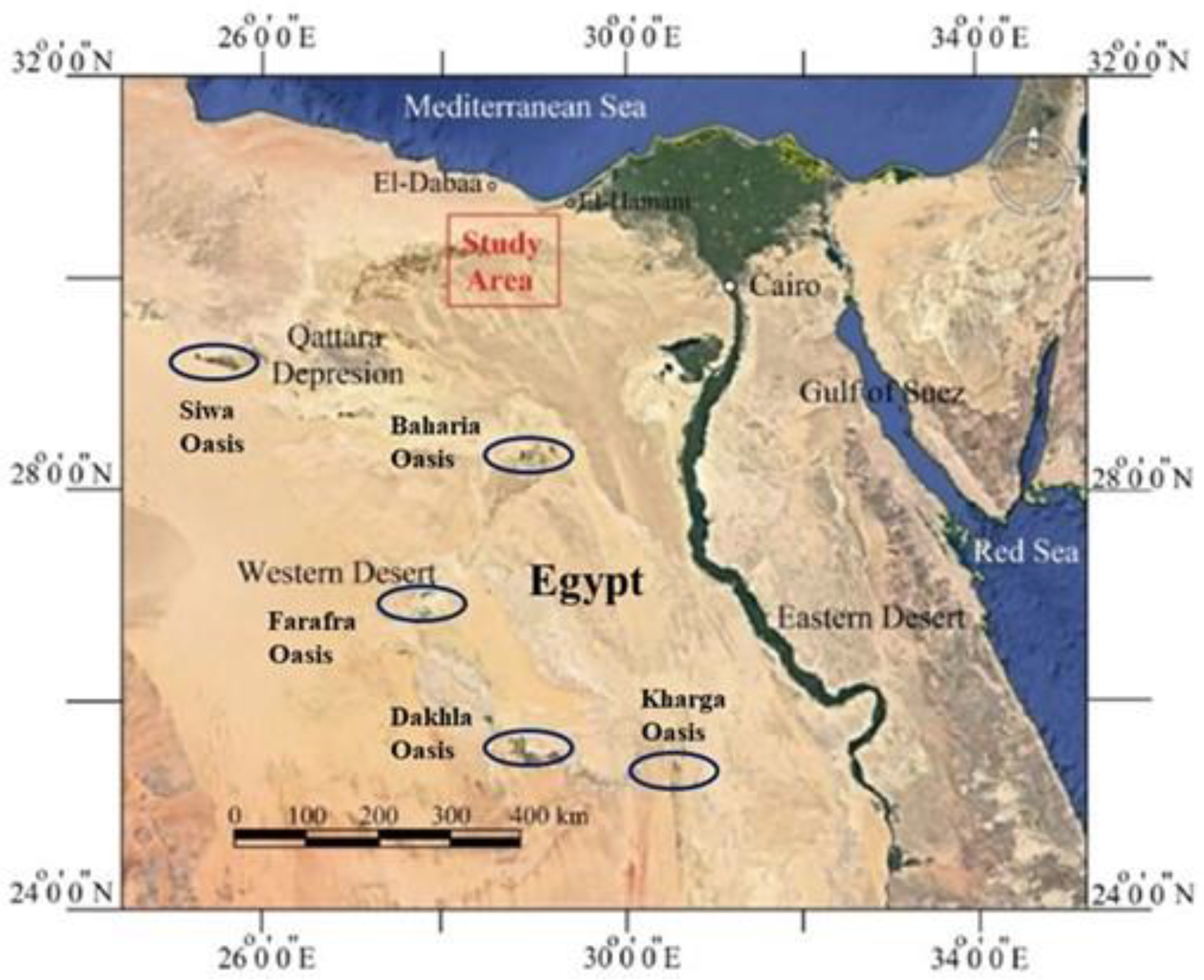
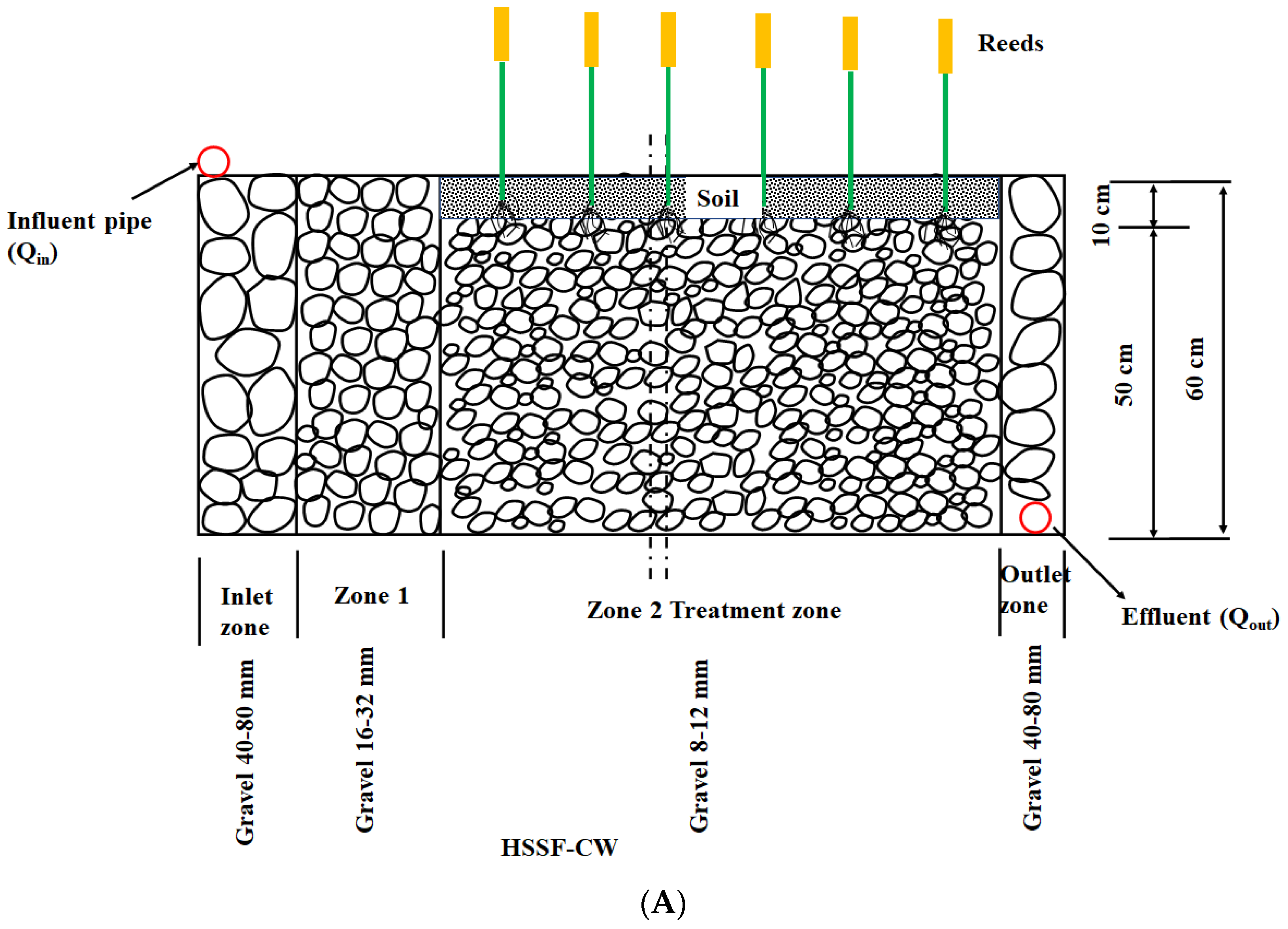
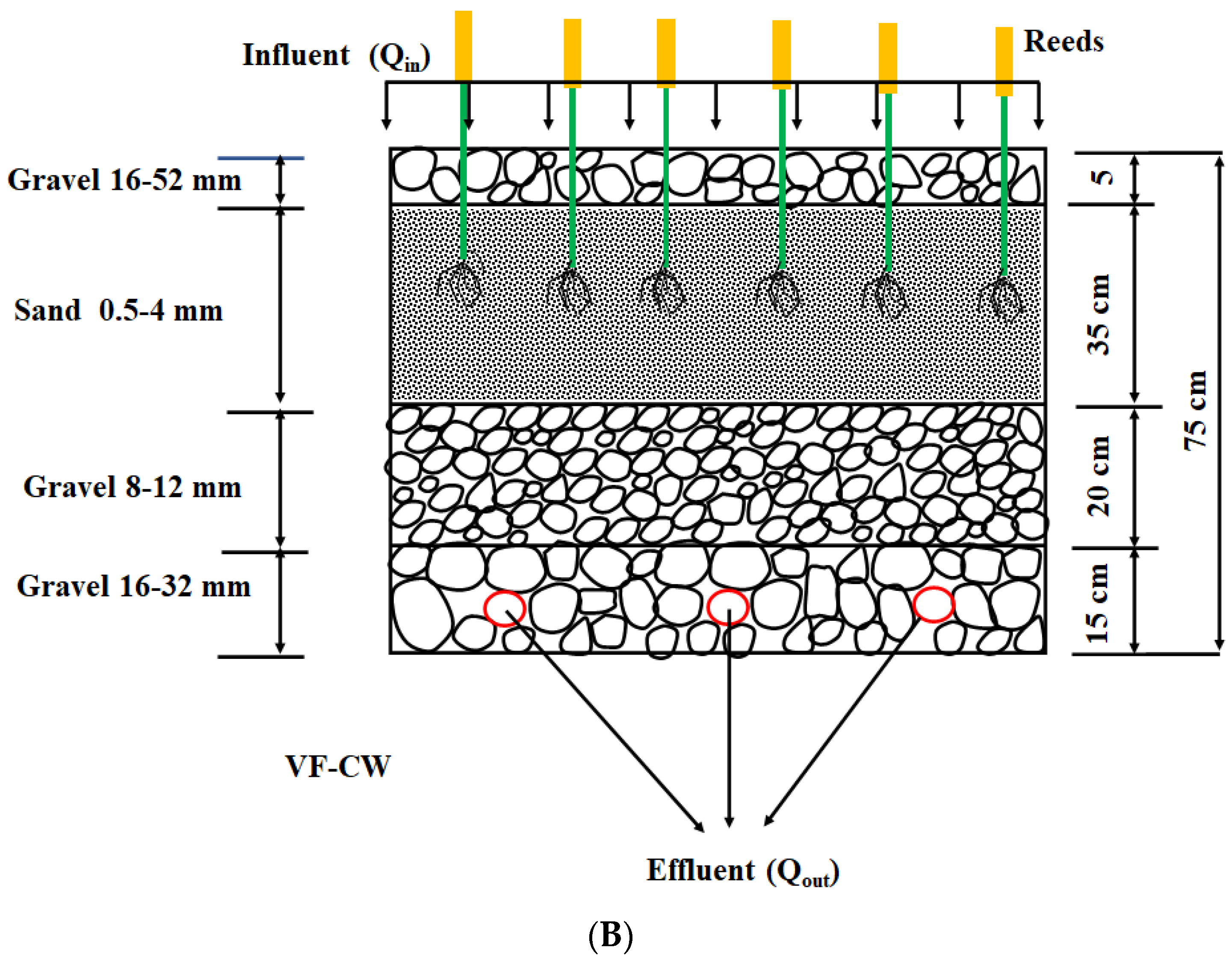
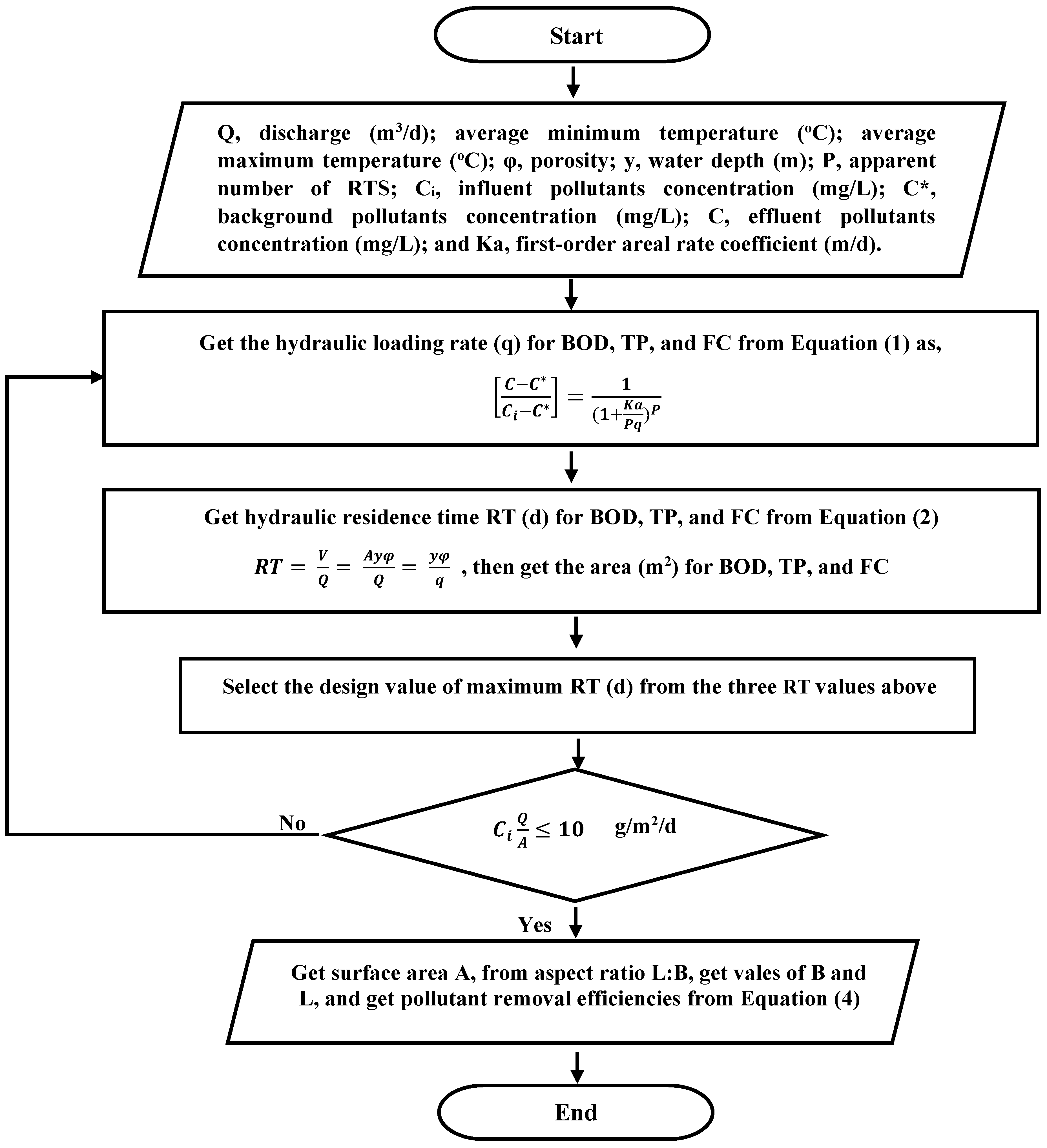
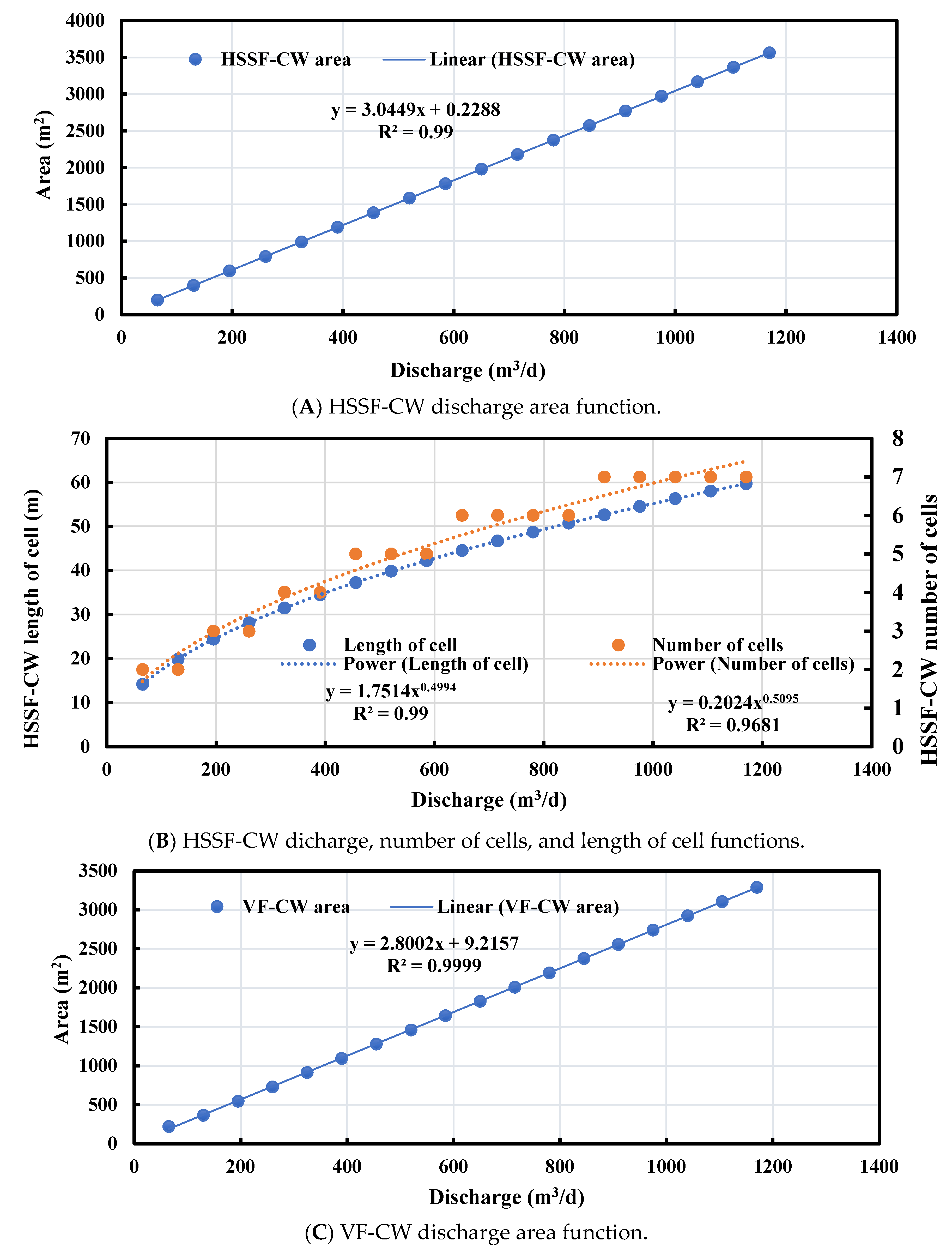
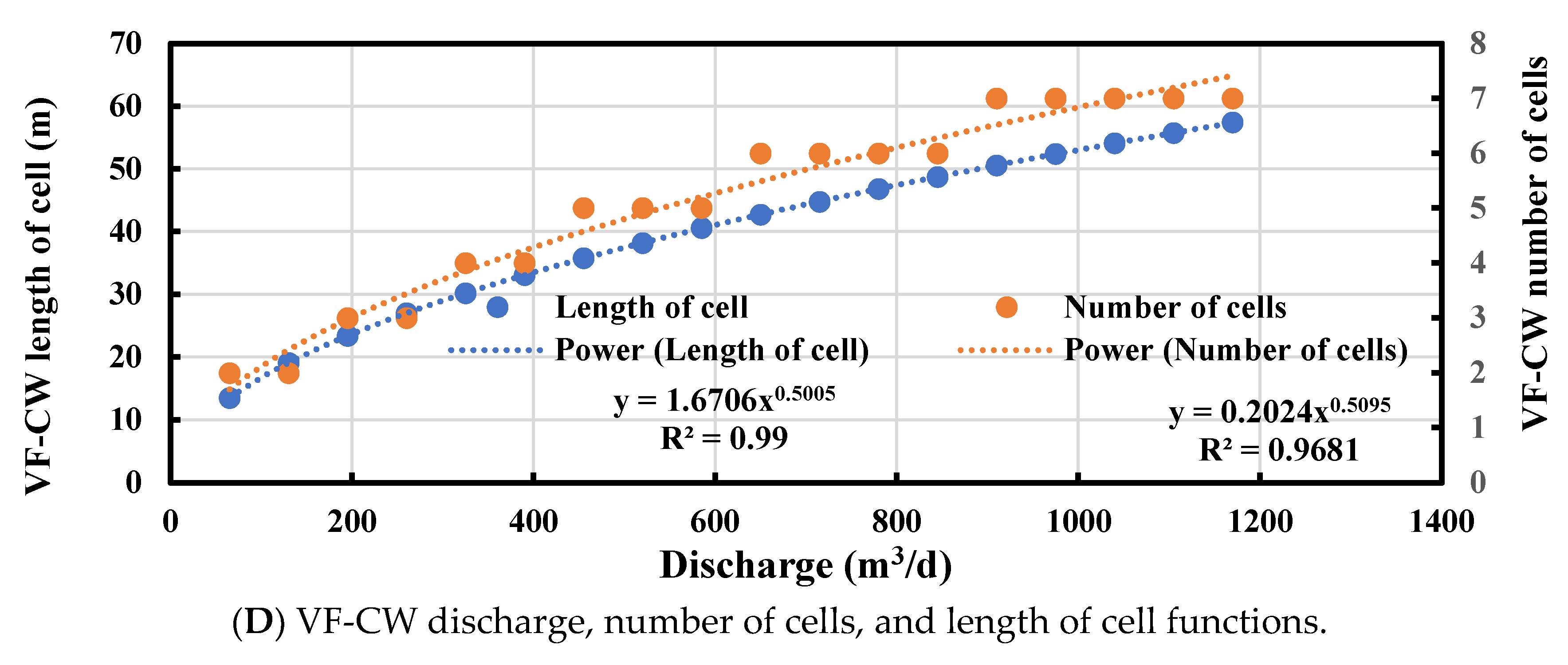
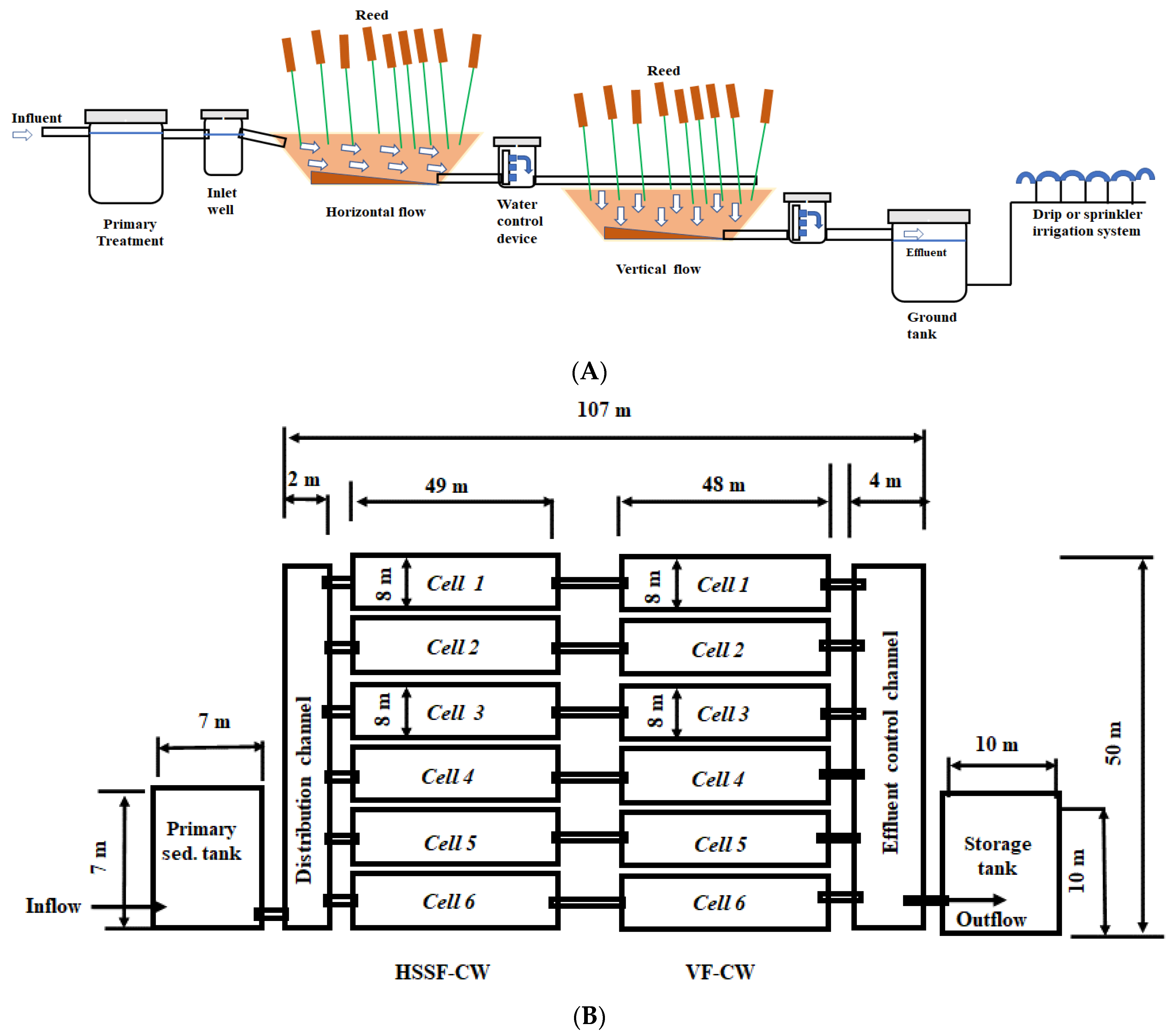
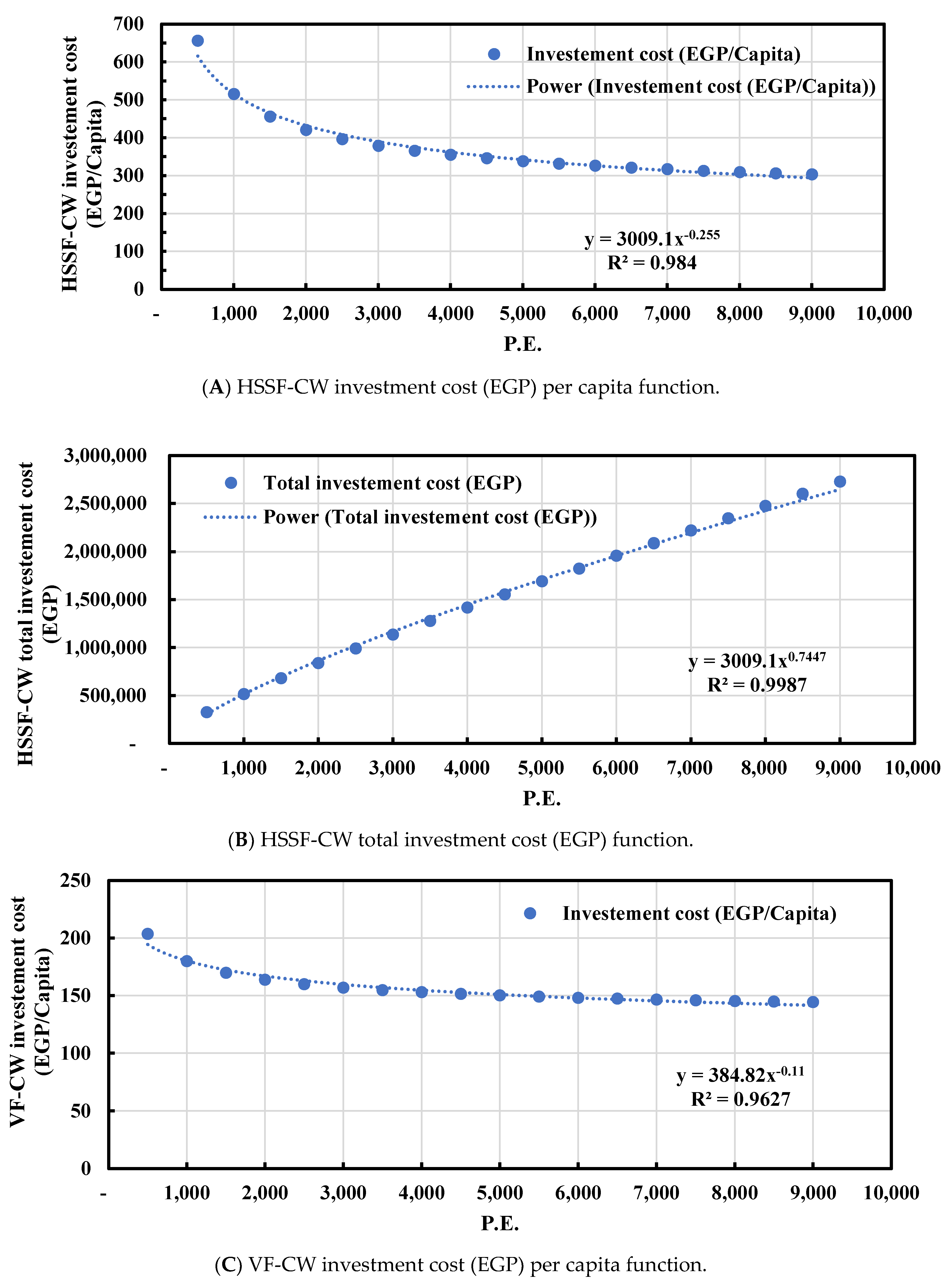
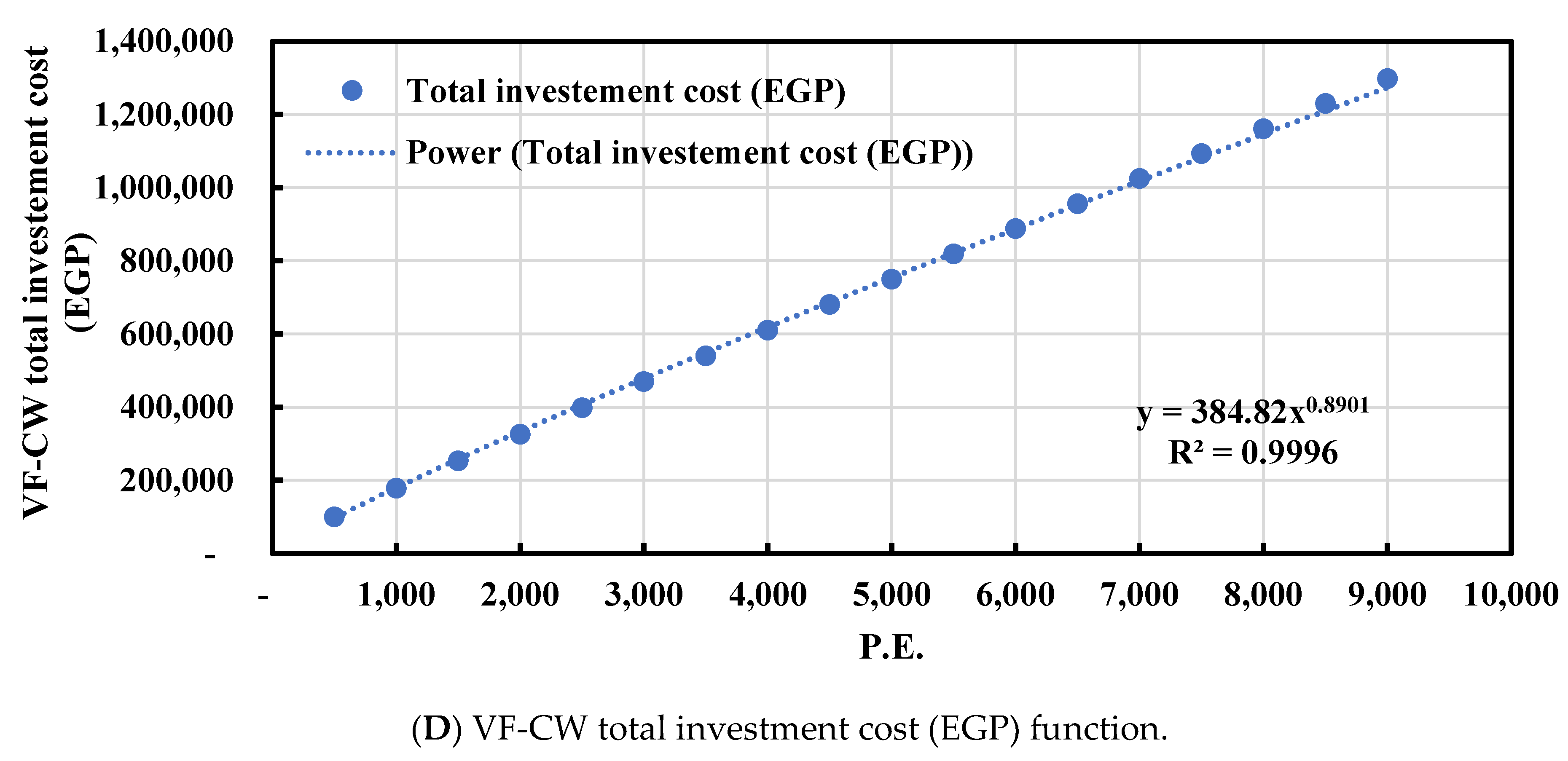
| Parameter | Unit | Influent Concentration Values | Effluent Concentration Values | Removal Efficiency (%) |
|---|---|---|---|---|
| COD | mg/L | 600 | 420 | 30 |
| BOD | mg/L | 300 | 210 | 30 |
| TP | mg/L | 10 | 7 | 30 |
| TN | mg/L | 43 | 30 | 30.2 |
| TSS | mg/L | 1000 | 400 | 60 |
| FC | Counts/100 mL | 107 | 106 | 90 |
| HSSF-CW | |||||||||||
|---|---|---|---|---|---|---|---|---|---|---|---|
| Q (m3/d) | Average Min. Temperature (°C) | Average Max. Temperature (°C) | Water Depth (m) | Apparent Number of RTS (P) | Influent Pollutants | C* | C | (m/d) | WE (%) | ||
| 780 | 14.2 | 24.4 | 0.3 | 0.6 | 3 | BOD (mg/L) | 210 | 1 | 50 | 0.662 | 76.2 |
| TP (mg/L) | 7 | 0.119 | 4.5 | 0.16 | 35.7 | ||||||
| FC (Counts/100 mL) | 106 | 4 | 104 | 1.492 | 99 | ||||||
| VF-CW | |||||||||||
| 780 | 14.2 | 24.4 | 0.75 | 3 | BOD (mg/L) | 50 | 1 | 10 | 0.662 | 80 | |
| TP (mg/L) | 4.5 | 0.119 | 3.0 | 0.16 | 33.3 | ||||||
| FC (Counts/100 mL) | 104 | 4 | 500 | 1.492 | 95 | ||||||
| HSSF-CW | |||
|---|---|---|---|
| BOD | TP | FC | |
| Area (m2) | 2198 | 2375 | 5712 |
| RT (d) | 0.5 | 0.55 | 1.3 |
| Surface load rate, q (m/d) | 0.35 | 0.33 | 0.33 |
| Efficiency (WE) (%) | 76.2 | 35.7 | 99 |
| Design values | |||
| Area (m2) | 2375 | ||
| RT (d) | 0.55 | ||
| Surface load rate, q (m/d) | 0.33 | ||
| Efficiency (WE) (%) | 78.2 | 35.7 | 93.7 |
| VF-CW | |||
| BOD | TP | FC | |
| Area (m2) | 2648 | 2193 | 2700 |
| RT (d) | 0.77 | 0.63 | 0.78 |
| Surface load rate, q (m/d) | 0.29 | 0.36 | 0.36 |
| Efficiency (WE) (%) | 80 | 33.3 | 95 |
| Design values | |||
| Area (m2) | 2193 | ||
| RT (d) | 0.63 | ||
| Surface load rate, q (m/d) | 0.36 | ||
| Efficiency (WE) (%) | 75 | 35.7 | 92.7 |
| Parameter | Unit | Influent Concentration Values | P.S Effluent | WE (%) | HSSF-CW Effluent | WE (%) | VF-CW Effluent | WE (%) | Overall Cumulative Efficiency WE (%) |
|---|---|---|---|---|---|---|---|---|---|
| BOD | mg/L | 300 | 210 | 30 | 50 | 76.2 | 10 | 80.0 | 96.67 |
| TP | mg/L | 10 | 7 | 30 | 4.5 | 35.7 | 3 | 33.3 | 70.00 |
| FC | Counts/100 mL | 10,000,000 | 1,000,000 | 90 | 10,000 | 99.0 | 500 | 95.0 | 100.00 |
| P.E. | Wastewater Consumption (WC) (m3/C/d) | Discharge (Q) (m3/d) | HSSF-CW Area (m2) | Number of Cells (n) | Length of Cell (L) (m) | Width of Cell (B) (m) | Aspect Ratio for CW | Aspect Ratio for Cell |
|---|---|---|---|---|---|---|---|---|
| 500 | 0.13 | 65 | 198 | 2 | 14.1 | 8 | 0.9 | 1.8 |
| 1000 | 0.13 | 130 | 396 | 2 | 19.9 | 8 | 1.2 | 2.5 |
| 1500 | 0.13 | 195 | 594 | 3 | 24.4 | 8 | 1.0 | 3.1 |
| 2000 | 0.13 | 260 | 792 | 3 | 28.1 | 8 | 1.2 | 3.5 |
| 2500 | 0.13 | 325 | 990 | 4 | 31.5 | 8 | 1.0 | 3.9 |
| 3000 | 0.13 | 390 | 1188 | 4 | 34.5 | 8 | 1.1 | 4.3 |
| 3500 | 0.13 | 455 | 1386 | 5 | 37.2 | 8 | 0.9 | 4.7 |
| 4000 | 0.13 | 520 | 1584 | 5 | 39.8 | 8 | 1.0 | 5.0 |
| 4500 | 0.13 | 585 | 1781 | 5 | 42.2 | 8 | 1.1 | 5.3 |
| 5000 | 0.13 | 650 | 1979 | 6 | 44.5 | 8 | 0.9 | 5.6 |
| 5500 | 0.13 | 715 | 2177 | 6 | 46.7 | 8 | 1.0 | 5.8 |
| 6000 | 0.13 | 780 | 2375 | 6 | 48.7 | 8 | 1.0 | 6.1 |
| 6500 | 0.13 | 845 | 2573 | 6 | 50.7 | 8 | 1.1 | 6.3 |
| 7000 | 0.13 | 910 | 2771 | 7 | 52.6 | 8 | 0.9 | 6.6 |
| 7500 | 0.13 | 975 | 2969 | 7 | 54.5 | 8 | 1.0 | 6.8 |
| 8000 | 0.13 | 1040 | 3167 | 7 | 56.3 | 8 | 1.0 | 7.0 |
| 8500 | 0.13 | 1105 | 3365 | 7 | 58 | 8 | 1.0 | 7.3 |
| 9000 | 0.13 | 1170 | 3563 | 7 | 59.7 | 8 | 1.1 | 7.5 |
| P.E. | Wastewater Consumption (WC) (m3/C/d) | Discharge (Q) (m3/d) | HSSF-CW Area (m2) | Number of Cells (n) | Length of Cell (L) (m) | Width of Cell (B) (m) | Aspect Ratio for CW | Aspect Ratio for Cell |
|---|---|---|---|---|---|---|---|---|
| 500 | 0.13 | 65 | 224 | 2 | 13.5 | 8 | 0.8 | 1.7 |
| 1000 | 0.13 | 130 | 366 | 2 | 19.1 | 8 | 1.2 | 2.4 |
| 1500 | 0.13 | 195 | 548 | 3 | 23.4 | 8 | 1.0 | 2.9 |
| 2000 | 0.13 | 260 | 731 | 3 | 27 | 8 | 1.1 | 3.4 |
| 2500 | 0.13 | 325 | 914 | 4 | 30.2 | 8 | 0.9 | 3.8 |
| 3000 | 0.13 | 390 | 1096 | 4 | 33.1 | 8 | 1.0 | 4.1 |
| 3500 | 0.13 | 455 | 1279 | 5 | 35.8 | 8 | 0.9 | 4.5 |
| 4000 | 0.13 | 520 | 1462 | 5 | 38.2 | 8 | 1.0 | 4.8 |
| 4500 | 0.13 | 585 | 1645 | 5 | 40.6 | 8 | 1.0 | 5.1 |
| 5000 | 0.13 | 650 | 1827 | 6 | 42.7 | 8 | 0.9 | 5.3 |
| 5500 | 0.13 | 715 | 2010 | 6 | 44.8 | 8 | 0.9 | 5.6 |
| 6000 | 0.13 | 780 | 2193 | 6 | 46.8 | 8 | 1.0 | 5.9 |
| 6500 | 0.13 | 845 | 2376 | 6 | 48.7 | 8 | 1.0 | 6.1 |
| 7000 | 0.13 | 910 | 2558 | 7 | 50.6 | 8 | 0.9 | 6.3 |
| 7500 | 0.13 | 975 | 2741 | 7 | 52.4 | 8 | 0.9 | 6.6 |
| 8000 | 0.13 | 1040 | 2924 | 7 | 54.1 | 8 | 1.0 | 6.8 |
| 8500 | 0.13 | 1105 | 3107 | 7 | 55.7 | 8 | 1.0 | 7.0 |
| 9000 | 0.13 | 1170 | 3289 | 7 | 57.4 | 8 | 1.0 | 7.2 |
| Month | Inflow (m3/d) | Rainfall (mm/d) | Rainfall (m3/d) | ETo (mm/d) | ETo (m3/d) | Outflow (m3/d) | Water Losses (%) |
|---|---|---|---|---|---|---|---|
| January | 780 | 1.0 | 2.4 | 2.9 | 17.2 | 765.2 | 1.9 |
| February | 780 | 0.6 | 1.4 | 3.47 | 20.6 | 761.9 | 2.3 |
| March | 780 | 0.3 | 0.6 | 3.99 | 23.7 | 758.8 | 2.7 |
| April | 780 | 0.1 | 0.2 | 4.96 | 29.5 | 753.1 | 3.5 |
| May | 780 | 0.1 | 0.2 | 5.5 | 32.7 | 749.8 | 3.9 |
| June | 780 | 0.0 | 0.1 | 5.99 | 35.6 | 746.9 | 4.2 |
| July | 780 | 0.0 | 0.0 | 6.02 | 35.7 | 746.8 | 4.3 |
| August | 780 | 0.0 | 0.0 | 6.03 | 35.8 | 746.7 | 4.3 |
| September | 780 | 0.0 | 0.1 | 5.43 | 32.2 | 750.3 | 3.8 |
| October | 780 | 0.4 | 0.9 | 4.45 | 26.4 | 756.1 | 3.1 |
| November | 780 | 0.5 | 1.2 | 3.6 | 21.4 | 761.1 | 2.4 |
| December | 780 | 0.9 | 2.1 | 3.04 | 18.1 | 764.5 | 2.0 |
| Month | Inflow (m3/d) | Rainfall (mm/d) | Rainfall (m3/d) | ETo (mm/d) | ETo (m3/d) | Outflow (m3/d) | Water Losses (%) |
|---|---|---|---|---|---|---|---|
| January | 780 | 1.0 | 2.9 | 2.9 | 15.9 | 766.3 | 1.8 |
| February | 780 | 0.6 | 3.47 | 3.47 | 19.0 | 762.3 | 2.3 |
| March | 780 | 0.3 | 3.99 | 3.99 | 21.9 | 758.7 | 2.7 |
| April | 780 | 0.1 | 4.96 | 4.96 | 27.2 | 753.0 | 3.5 |
| May | 780 | 0.1 | 5.5 | 5.5 | 30.2 | 750.0 | 3.8 |
| June | 780 | 0.0 | 5.99 | 5.99 | 32.8 | 747.2 | 4.2 |
| July | 780 | 0.0 | 6.02 | 6.02 | 33.0 | 747.0 | 4.2 |
| August | 780 | 0.0 | 6.03 | 6.03 | 33.1 | 746.9 | 4.2 |
| September | 780 | 0.0 | 5.43 | 5.43 | 29.8 | 750.3 | 3.8 |
| October | 780 | 0.4 | 4.45 | 4.45 | 24.4 | 756.5 | 3.0 |
| November | 780 | 0.5 | 3.6 | 3.6 | 19.7 | 761.3 | 2.4 |
| December | 780 | 0.9 | 3.04 | 3.04 | 16.7 | 765.3 | 1.9 |
| Type of Wetland | Temp. (°C) | Plants | Discharge (m3/d) | Pollutants Concentrations | Removal Efficiency (%) | Surface Area (A) (ha) | |
|---|---|---|---|---|---|---|---|
| Inlet Flow (Ci) (mg/L) | Outlet Flow (C) (mg/L) | ||||||
| Proposed HSSF-CW | 14.2–24.4 | Phragmites australis and Papyrus | 780 | BOD = 210 TP = 7 FC = 106 (Counts/100 mL) | BOD = 46 TP = 4.5 FC = 6.3 106 (Counts/100 mL) | BOD = 78.2 TP = 35.7 FC = 93.7 | 0.2735 |
| Proposed VF-CW | 14.2–24.4 | Phragmites australis and Papyrus | 780 | BOD = 46 TP = 4.5 FC = 104 (Counts/100 mL) | BOD = 11.5 TP = 2.9 FC = 4599 (Counts/100 mL) | BOD = 75 TP = 33.7 FC = 92.7 | 0.2193 |
| HSSF-CW -Pilot scale in Karachi, NED University of Engineering and Technology [49] | 20-36 | Phragmites australis | 1 | BOD = 68.6 ± 23.6 TP = 7.6 ± 1.9 FC = 1.1 × 106 (Counts/100 mL) | BOD = 34.15 ± 15.5 TP = 3.7 ± 2.3 FC = 2.2 104 (Counts/100 mL) | BOD = 50 TP = 52 FC = 98 | - |
| Lake Manzala reciprocating wetland system, Egypt [43] | 14.1–27.8 | Unplanted | 250 | BOD = 25 FC = 3342 (Counts/100 mL) | BOD = 4 FC = 153 (Counts/100 mL) | BOD = 84 FC = 95.4 | 0.0324 |
| Agaa wastewater treatment, Delta of Egypt [30,50]. | 18 | Phragmites australis and Papyrus | 1500 | BOD = 250 | BOD = 60 | BOD = 76 | 0.184 |
Disclaimer/Publisher’s Note: The statements, opinions and data contained in all publications are solely those of the individual author(s) and contributor(s) and not of MDPI and/or the editor(s). MDPI and/or the editor(s) disclaim responsibility for any injury to people or property resulting from any ideas, methods, instructions or products referred to in the content. |
© 2023 by the authors. Licensee MDPI, Basel, Switzerland. This article is an open access article distributed under the terms and conditions of the Creative Commons Attribution (CC BY) license (https://creativecommons.org/licenses/by/4.0/).
Share and Cite
Gabr, M.E.; Al-Ansari, N.; Salem, A.; Awad, A. Proposing a Wetland-Based Economic Approach for Wastewater Treatment in Arid Regions as an Alternative Irrigation Water Source. Hydrology 2023, 10, 20. https://doi.org/10.3390/hydrology10010020
Gabr ME, Al-Ansari N, Salem A, Awad A. Proposing a Wetland-Based Economic Approach for Wastewater Treatment in Arid Regions as an Alternative Irrigation Water Source. Hydrology. 2023; 10(1):20. https://doi.org/10.3390/hydrology10010020
Chicago/Turabian StyleGabr, Mohamed Elsayed, Nadhir Al-Ansari, Ali Salem, and Ahmed Awad. 2023. "Proposing a Wetland-Based Economic Approach for Wastewater Treatment in Arid Regions as an Alternative Irrigation Water Source" Hydrology 10, no. 1: 20. https://doi.org/10.3390/hydrology10010020
APA StyleGabr, M. E., Al-Ansari, N., Salem, A., & Awad, A. (2023). Proposing a Wetland-Based Economic Approach for Wastewater Treatment in Arid Regions as an Alternative Irrigation Water Source. Hydrology, 10(1), 20. https://doi.org/10.3390/hydrology10010020









